Physical Address
304 North Cardinal St.
Dorchester Center, MA 02124
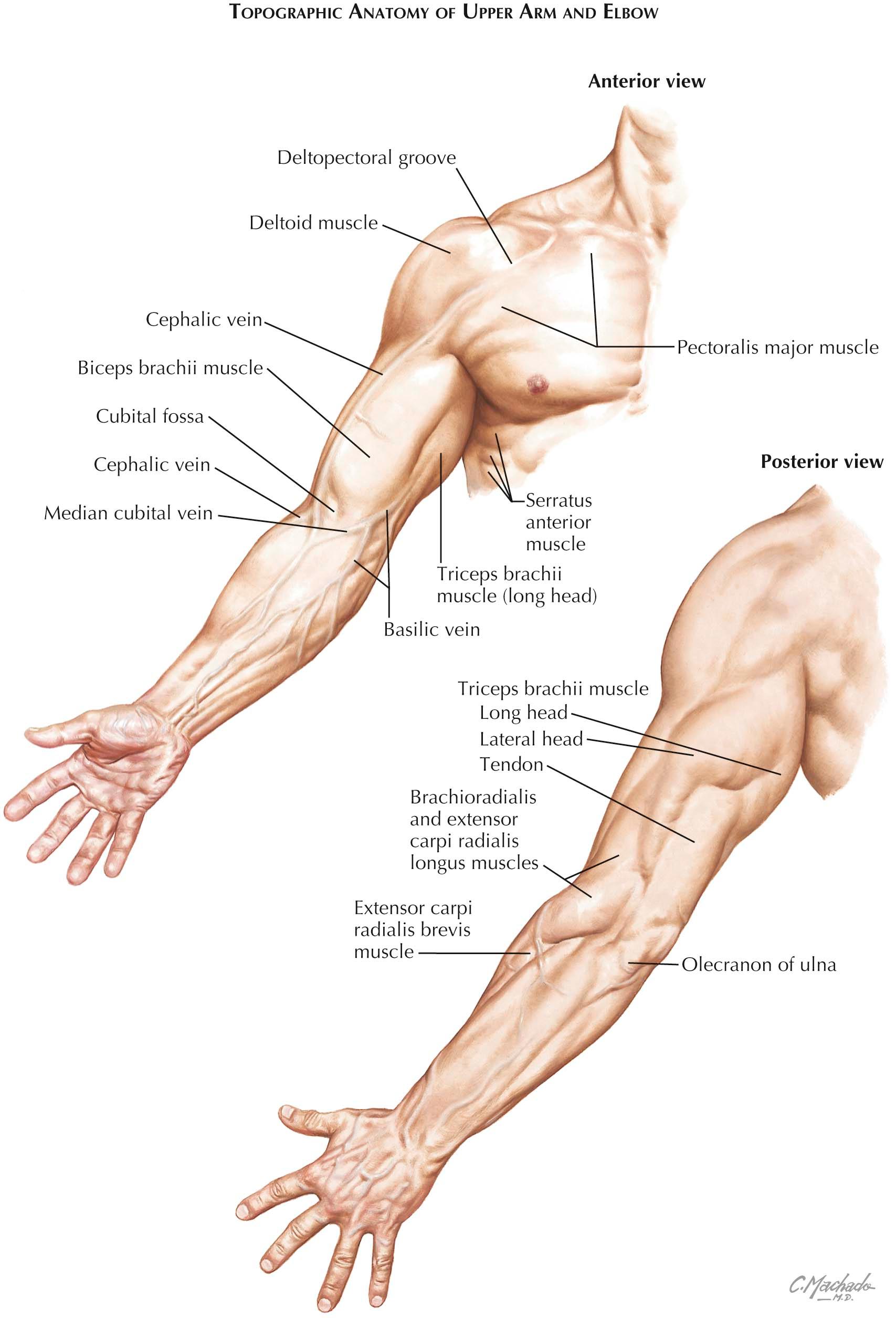
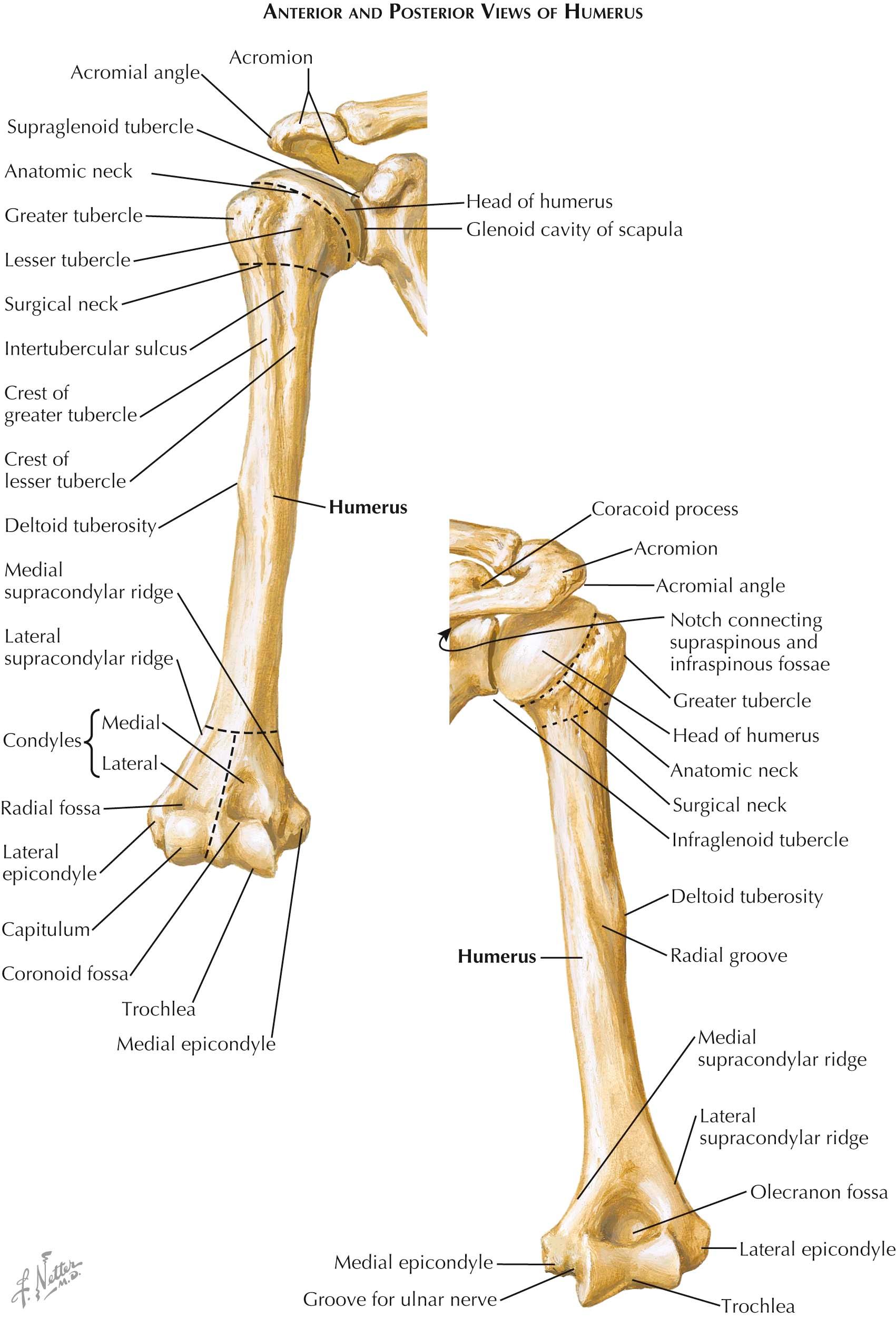
Anteriorly, the contour of the biceps muscle is seen starting in the upper arm and extending distally into the cubital fossa, which is the inverted triangular depression on the anterior aspect of the elbow. The flexion crease along the anterior elbow is in line with the medial and lateral epicondyles and is 1 to 2 cm proximal to the joint line when the elbow is extended. The superficial cephalic and basilic veins are the most prominent superficial major contributions of the anterior venous system and communicate by way of the median cephalic and median basilic veins to form a pattern resembling an M over the cubital fossa. Laterally, the tip of the olecranon, the lateral epicondyle, and the radial head form a palpable triangle called the posterolateral soft spot that can show evidence of an effusion from the elbow joint and serves as an important landmark for joint aspiration and for elbow arthroscopy. The proximal extensor forearm musculature originates from the lateral epicondyle and forms the lateral margin of the cubital fossa and the lateral contour of the forearm and comprises the brachioradialis and the extensor carpi radialis longus and brevis muscles. The proximal flexor pronator musculature forms the contour of the medial anterior forearm extending from the medial epicondyle and includes the pronator teres, flexor carpi radialis, palmaris longus, and flexor carpi ulnaris. The relationship of these muscles can be approximated by placing the opposing thumb and the index, long, and ring fingers over the anterior medial forearm. Posteriorly, the contour of the triceps muscle is seen in the upper arm extending to the tip of the olecranon. More distally, the proximal forearm is contoured dorsally by the lateral extensor musculature, consisting of the anconeus, extensor carpi ulnaris, extensor digitorum quinti, and extensor digitorum communis.
The main bone of the upper arm is the humerus. It is a long bone composed of a shaft and two articular extremities. The proximal humerus, which includes the humeral head, greater and lesser tuberosity, and surgical neck, is discussed in detail in Section I , Shoulder. The body, or shaft, of the humerus begins just below the surgical neck. It is somewhat rounded above and prismatic in its lower portion. Above and medially, the coracobrachialis muscle is received near the middle of the shaft; about opposite laterally is the prominent deltoid tuberosity. This is continued upward in a V -shaped roughening for the insertion of the deltoid muscle. Just below the deltoid tuberosity, a groove for the radial nerve indents the bone posteriorly, spiraling lateralward as it descends. Sharp lateral and medial supracondylar ridges spring from the respective borders inferiorly and continue into the lateral and medial epicondyles of the humerus. The inferior extremity of the bone is flattened anteroposteriorly and mediolaterally, and it is widened by the medial and lateral epicondyles. The lateral epicondyle is not conspicuous, but the medial epicondyle forms a marked medial projection above the elbow. Projecting somewhat backward, it is grooved behind for the ulnar nerve.
The articular surfaces for the radius, ulna, capitellum, and trochlea are directed somewhat forward; consequently, the inferior extremity of the humerus appears to curve anteriorly. The capitellum is roughly globular. Smaller than the trochlea, it articulates with the cupped upper surface of the radius. Above it is a shallow fossa, t he radial fossa, for the reception of the edge of that bone during full flexion of the elbow. The trochlea is shaped like a spool, with a deep depression between two well-marked margins. The depression is slightly spiral and receives the central ridge of the trochlear notch of the ulna. The medial rim of the trochlea is the more prominent; the lateral rim is only a small elevation separating the trochlea from the capitellum. Above the trochlea is the coronoid fossa for the reception of the coronoid process of the ulna in front and the olecranon fossa for the olecranon behind.
The humerus ossifies from eight centers of ossification: one for the shaft and seven for the processes—head, greater and lesser tuberosities, trochlea, capitellum, lateral epicondyle, and medial epicondyle. The shaft appears near the middle of the bone in the eighth week of fetal life and then extends toward its extremities. At birth, the humerus is ossified in nearly its whole length; only its extremities remain cartilaginous. Shortly after birth, ossification begins in the head of the bone, followed by the appearance of the centers in the greater and lesser tuberosities at 3 to 5 years of age, respectively. By age 6, all these centers have merged into one large epiphysis. In the distal humerus, secondary centers appear for the capitellum at age 2, for the trochlea at age 9 or 10, and in the lateral epicondyle at ages 13 to 14. These centers unite and fuse with the shaft at about age 13 in females and age 15 in males. The separate center for the medial epicondyle appears at ages 6 to 8 and fuses with the shaft at ages 14 to 16.
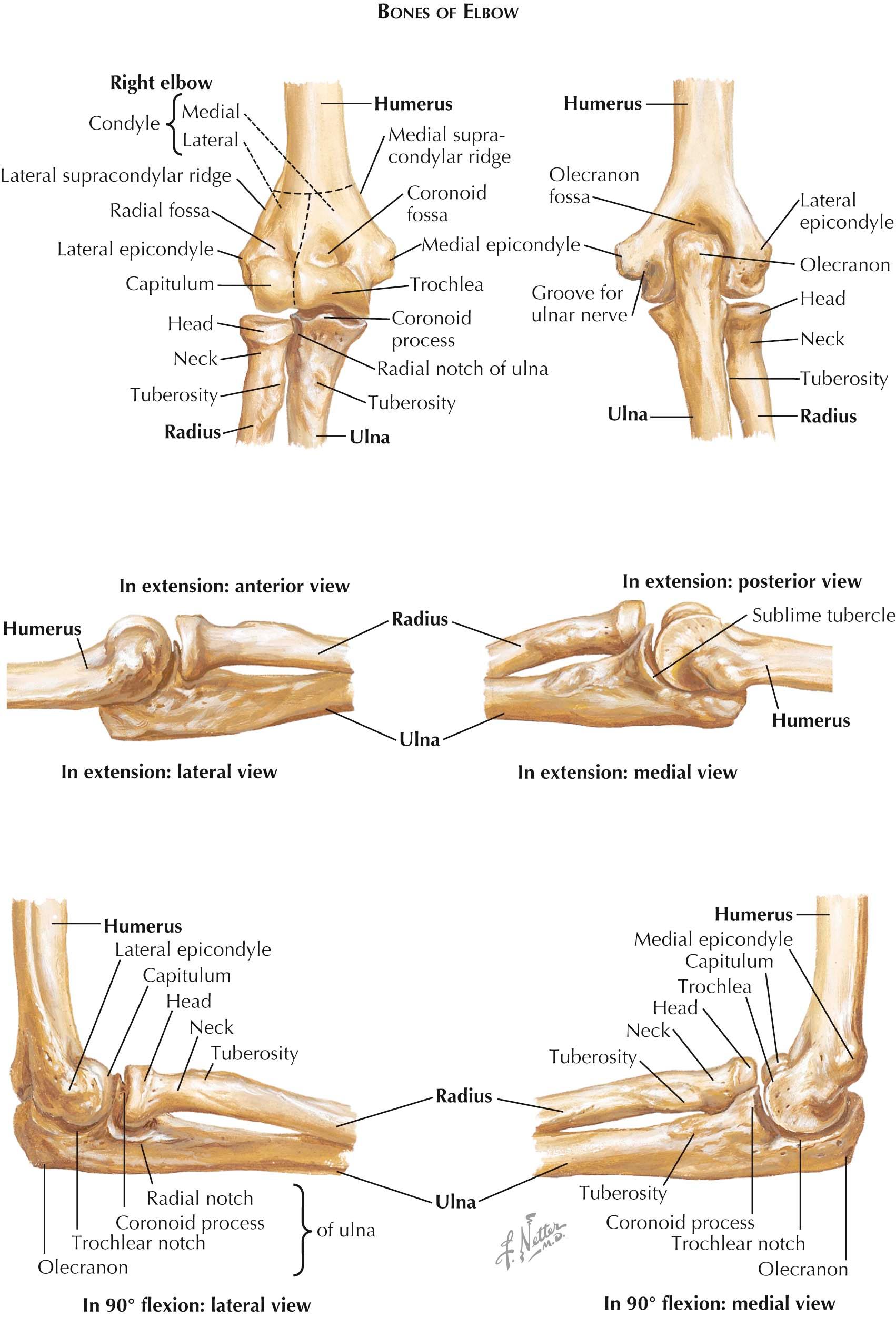

The elbow joint, comprising the humeroradial, humeroulnar, and proximal radioulnar articulations within a common capsule, necessarily involves the proximal portions of the radius and ulna, as well as the distal part of the humerus. The humeroulnar articulation acts as a hinge and allows flexion and extension of the elbow, whereas rotational movements occur through the humeroradial and proximal radioulnar articulations. Therefore, the elbow is not considered a simple hinge joint but rather a trochoginglymoid joint that possesses two degrees of freedom or motion: flexion-extension and pronation-supination. The center of rotation of the elbow runs through the center of the articular surface of the distal humerus formed by the trochlea and the capitellum, lying just anterior to the anterior cortex of the distal humerus on the lateral view. The carrying angle of the elbow, formed by the humerus and ulna with the hand and forearm fully supinated and the elbow fully extended, has been reported to range from 11 to 14 degrees of valgus in men and from 13 to 16 degrees of valgus in women. The carrying angle is typically about a degree greater on the dominant compared with the nondominant side. Valgus (cubitus valgus) or varus (cubitus varus) malalignment is diagnosed when the carrying angle is greater than or less than these normal values, respectively.
In the region of the elbow joint, the special parts of the radius are the head, neck, and tuberosity. The radial head is round; it is a thick disc, articular both on its circumference and over its cupped upper free surface. The latter surface articulates with the capitellum of the humerus. The articular circumference of the head is broader medially for contact with the radial notch of the ulna, forming a 240-degree arc for articulation with the ulna, and narrower where it is held by the annular ligament. The neck of the radius is the constriction below the head, and the tuberosity is an oval prominence just distal to the neck. Its posterior portion is roughened for the reception of the biceps brachii tendon; its anterior part is smooth and is in contact with the bicipitoradial bursa.
The proximal end of the ulna has a more complex architecture. Its heavy proximal extremity exhibits the opened jaws of the trochlear notch, the olecranon, the coronoid process, and the radial notch.
The trochlear notch is a concavity that describes about one third of a circle and is divided by a longitudinal ridge into medial and lateral parts. The waist of the notch is constricted, and a roughness across the waist separates the part deriving from the olecranon from the part formed by the coronoid process. The trochlear notch receives the trochlea of the humerus. In extreme flexion, the coronoid process of the ulna enters the coronoid fossa of the humerus; in extreme extension, the olecranon enters the olecranon fossa.
The olecranon contributes part of the trochlear notch and forms the posterior projection of the elbow. Its blunt end receives the tendon of the triceps brachii muscle and is attached to the capsule of the elbow joint along the bounding margin of the trochlear notch. Between these attachments, the bone is smooth for the subtendinous bursa of the triceps brachii muscle.
The coronoid process is a strong, triangular projection of the anterior surface of the ulna; it also forms the anterior part of the trochlear notch. The anterior surface of the coronoid process is rough for the insertion of the tendon of the brachialis muscle. The junction of this surface with the shaft is the location of the tuberosity of the ulna, which receives the oblique cord of the radius.
The radial notch of the ulna, a shallow concavity on the lateral aspect of the coronoid process, receives the circumferential articular surface of the head of the radius. Its prominent edges give attachment to the ends of the annular ligament of the radius.
The radius is ossified by means of a center of ossification that appears in the shaft (which is bony at birth) at the eighth week of intrauterine life. Ossification for the radial head begins at 4 or 5 years of age, and this portion fuses with the shaft at 14 to 16 years of age.
Ossification of the ulna begins near the middle of the shaft at the eighth week of intrauterine life, and the shaft is bony at birth.
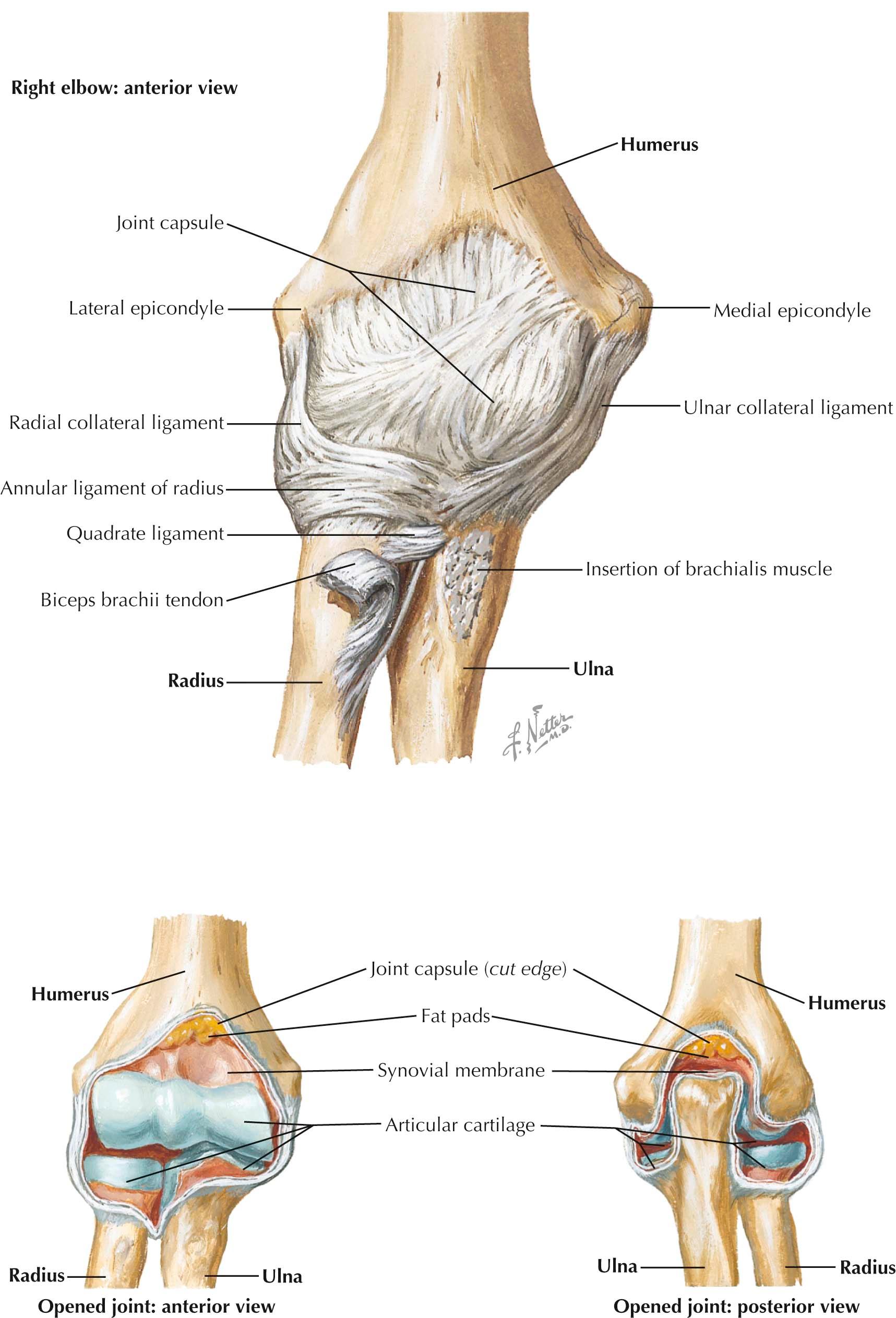
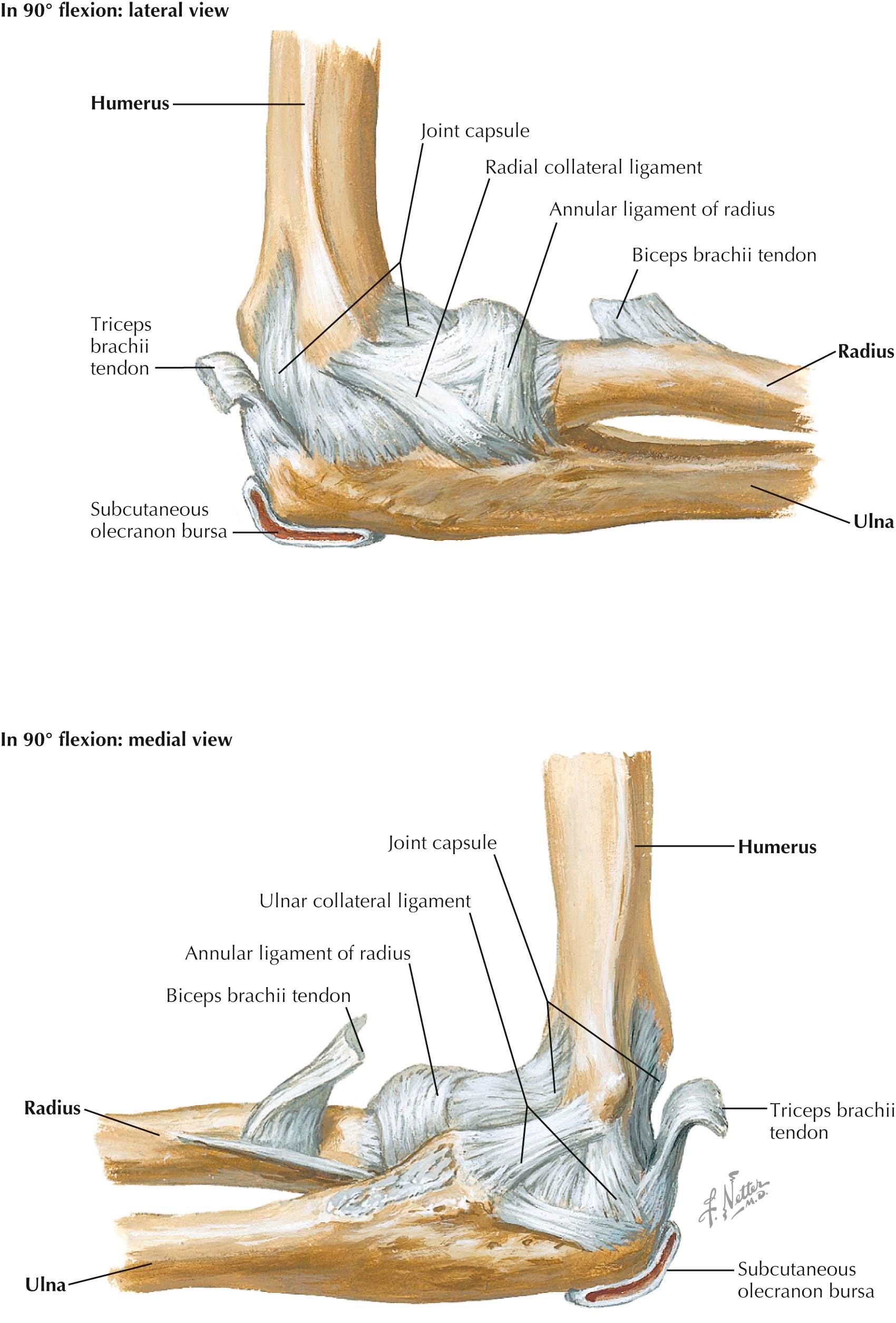
As discussed previously, the elbow is not just a simple hinge joint but instead possesses two degrees of freedom or motion: flexion-extension and pronation-supination. However, with the primary range of motion occurring in the flexion-extension direction, there are reciprocally convex and concave articular surfaces along the distal humerus, radius, and ulna; a capsule, loose on the sides toward which movement takes place; strong collateral ligaments; and a grouping of muscle masses at the borders where they are not in the direction of movement.
The articular surfaces are the spool-shaped trochlea and the rounded capitellum of the humerus proximally and the trochlear notch of the ulna and the cupped upper surface of the humeral head of the radius distally. The capitellum of the humerus is directed forward and downward, with the articular surfaces most completely in contact when the elbow is flexed to a 90-degree angle. Contact is weak between the humerus and the radius, and both the stability of the joint and its limitation of motion to flexion and extension are due to the ridged and grooved relationship of the humerus and the ulna.
The articular capsule is weak in front and behind but strengthened at the sides by the ulnar and radial collateral ligaments. In front, it is attached on the humerus from the medial to the lateral epicondyles along the superior borders of the coronoid and radial fossae. Distally, it is attached to the anterior border of the coronoid process of the ulna and to the annular ligament of the radius; it is continuous on either side with the collateral ligaments. The posterior portion of the capsule is membranous. Its attachments are the margins of the olecranon and the edges of the olecranon fossa, the lateral epicondyle, the annular ligament, and the posterior border of the radial notch of the ulna.
The collateral ligaments are strong, triangular thickenings of the articular capsule, attached by their apices to the medial and lateral epicondyles of the humerus. Their broader distal attachments are to the forearm bones and the annular ligament of the radius. These ligaments place strict limitations on side-to-side displacements of the joint.
The ulnar collateral ligament has thickened borders, with the anterior band reaching the medial edge of the coronoid process and the posterior band attaching to the corresponding edge of the olecranon. The thinner intermediate portion ends below, in transverse fibers stretched between the coronoid process and the olecranon.
The radial collateral ligament, a narrower, less distinct thickening, is stretched between the underside of the lateral epicondyle above and the annular ligament and the margins of the radial notch of the ulna below.
The synovial membrane of the elbow joint lines the capsule and is reflected onto the borders of the radial and coronoid fossae of the humerus in front and the olecranon fossa behind. Below, it continues into the proximal radioulnar articulation.
The hinge action at the elbow joint is not exactly in the line of the long axis of the humerus. In extension, the forearm deviates from a straight line with the arm, forming the carrying angle of the forearm, which is obliterated when the hand is pronated. As discussed previously, the carrying angle has been reported to range from 11 to 14 degrees of valgus in men and from 13 to 16 degrees of valgus in women. Because of a slight spiral orientation of the ridge of the trochlear notch and of the groove of the trochlea, flexion does not bring the forearm bones medial to the humerus. The habitual ease with which the hand is carried to the mouth in elbow flexion is due to the slight medial rotation of the humerus and the semipronated position of the hand.
The head of the radius rotates in a ring formed by the radial notch of the ulna and the annular ligament of the radius. The annular ligament of the radius is a strong, curved band attaching to the anterior and posterior margins of the radial notch of the ulna. It serves as a restraining ligament, which prevents withdrawal of the head of the radius from its socket. The annular ligament receives the radial collateral ligament and blends with the capsule of the elbow joint. Below, a lax band, called the quadrate ligament, passes from the lower border of the radial notch of the ulna to the adjacent medial surface of the neck of the radius.
The synovial membrane of this joint is continuous with that of the elbow joint. A reflection of the membrane below the annular ligament forms a loose sac around the neck of the radius, which accommodates to the rotation of the head of the radius.
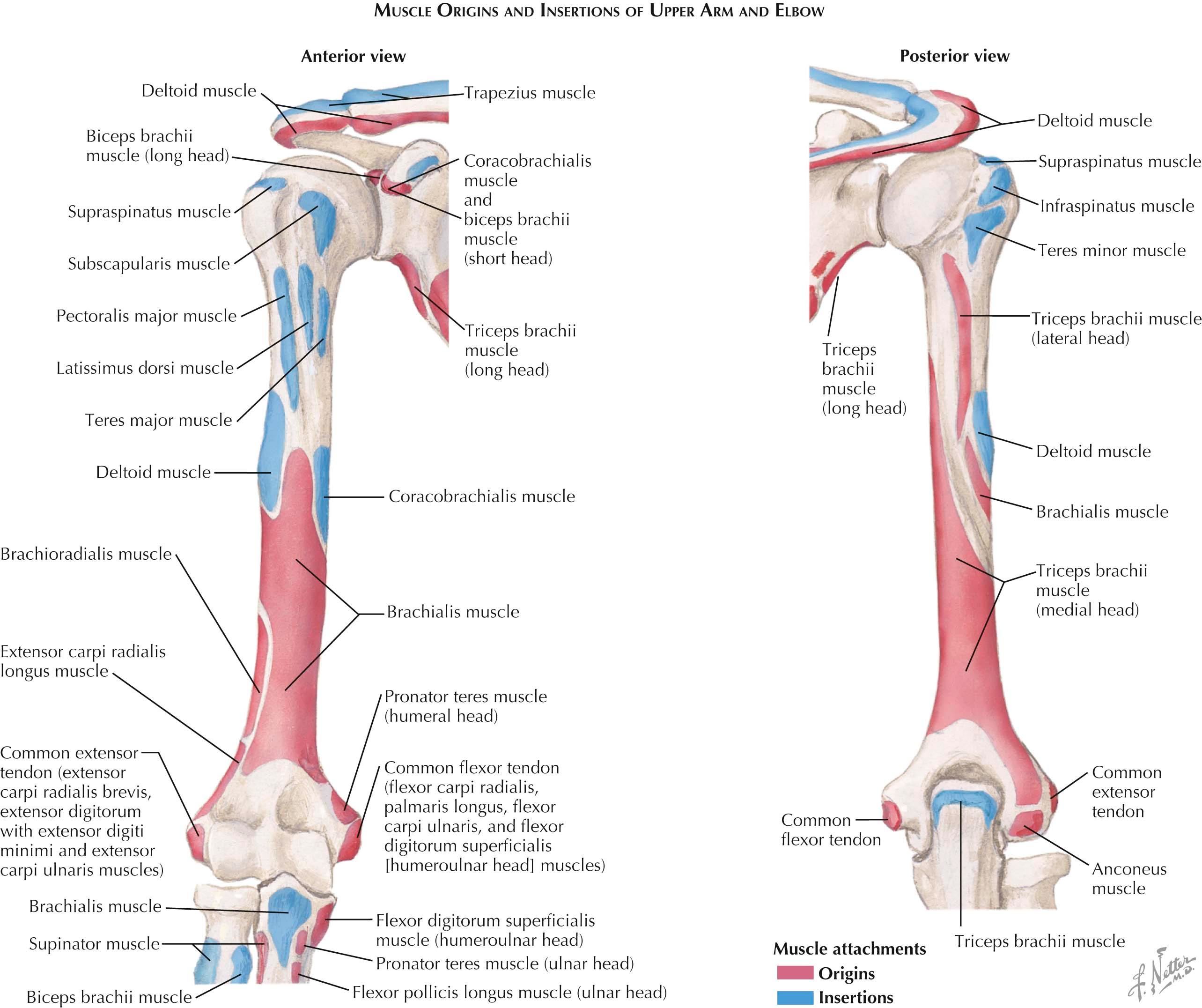
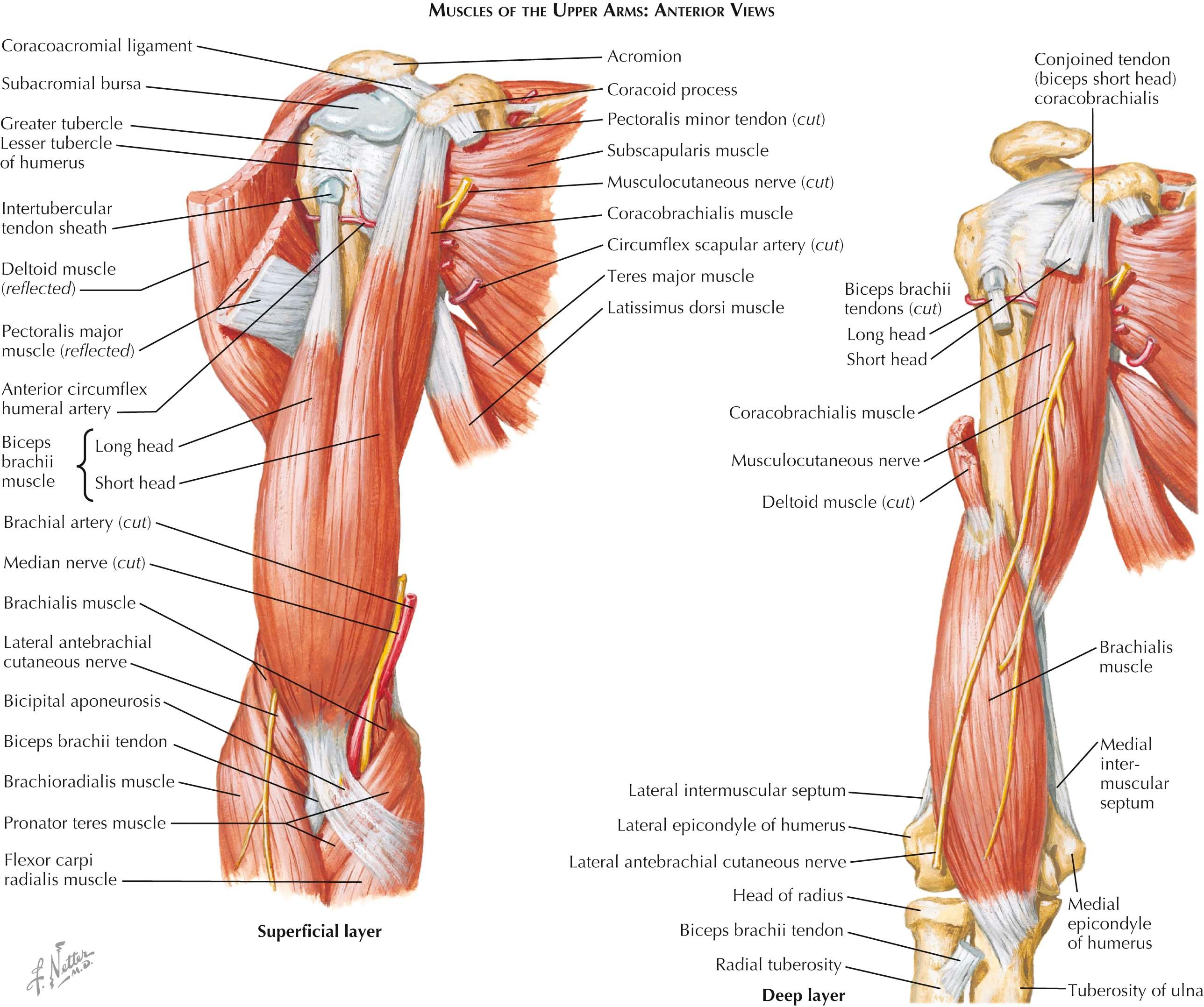
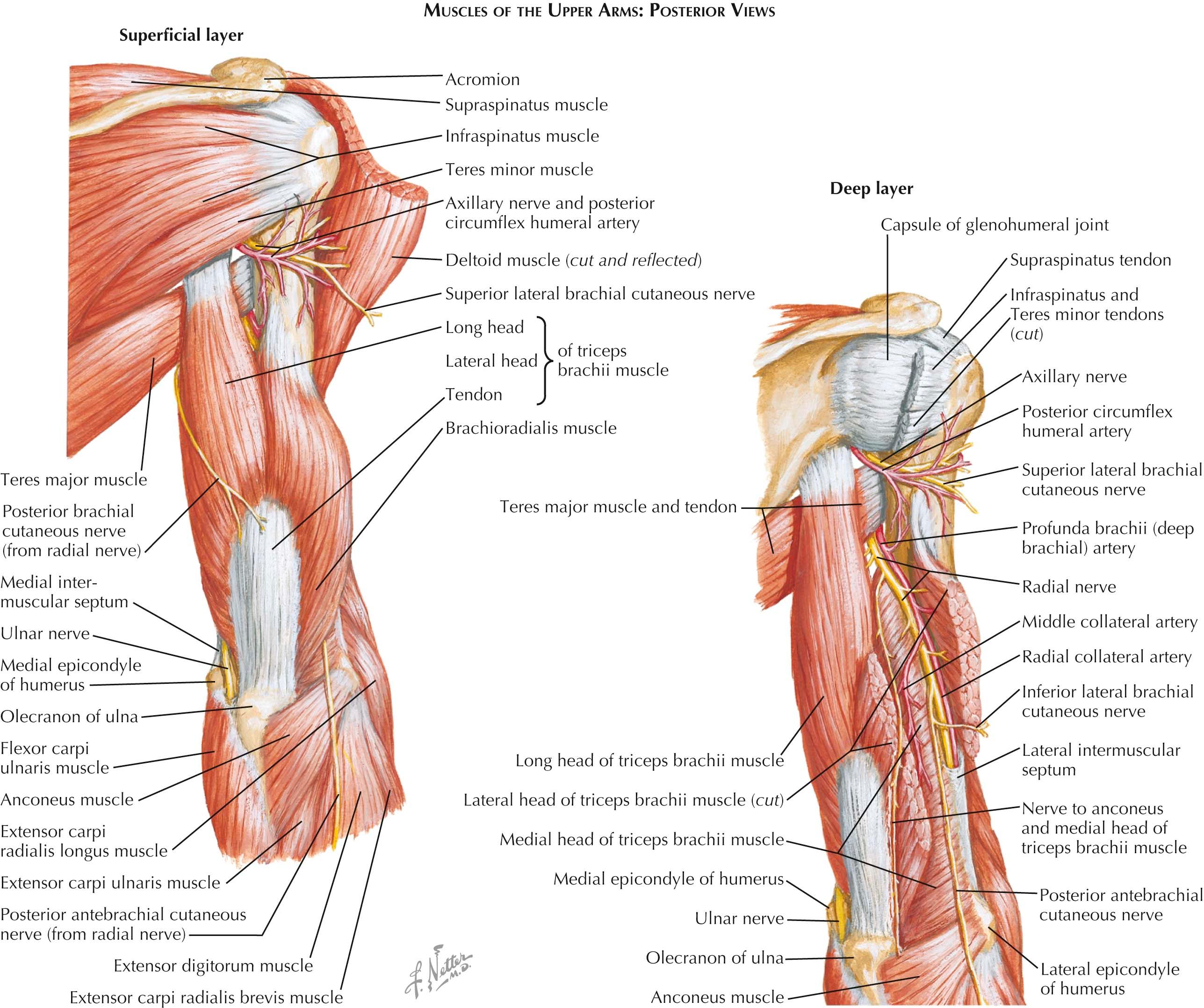
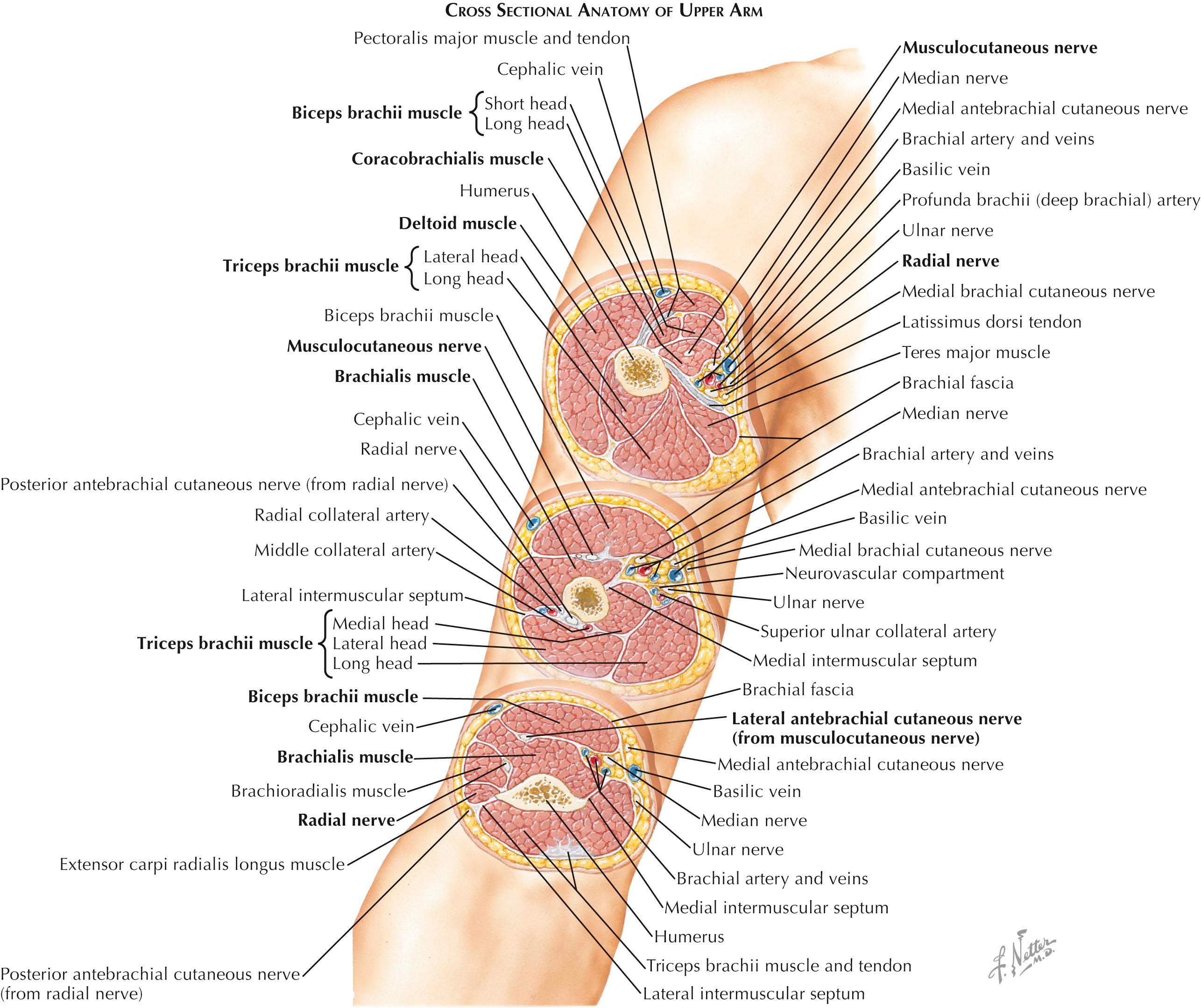
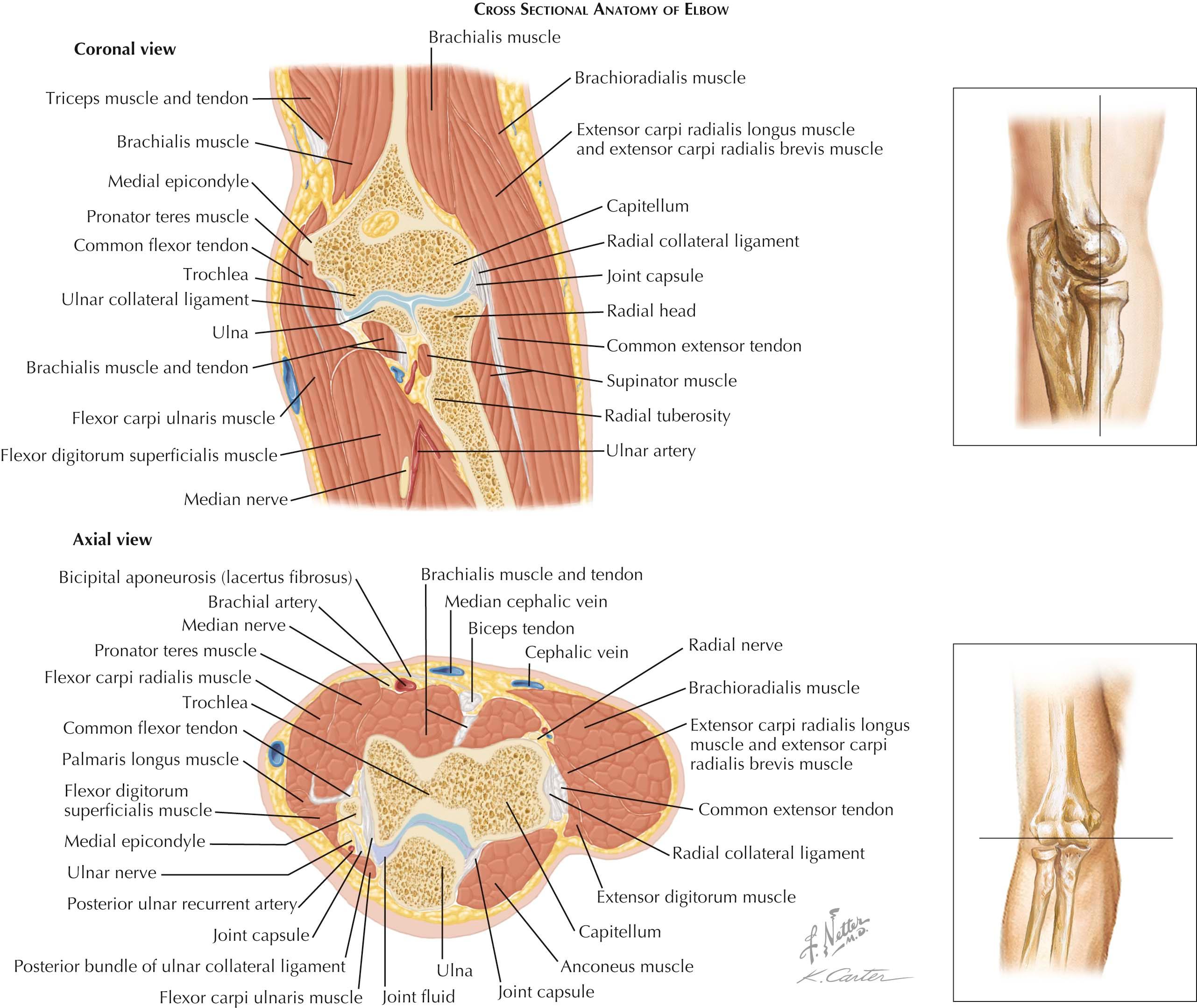
The arm, or brachium, is the region between the shoulder joint and the elbow. The arm muscles are few, and they are served by certain of the terminal branches of the brachial plexus and portions of the great vascular channels of the limb (see Plates 2-7 to 2-11 ).
A strong tubular investment of the deeper parts of the arm, the brachial fascia is continuous above with the pectoral and axillary fasciae and with the fascial covering of the deltoid and latissimus dorsi muscles. Below, the brachial fascia is attached to the epicondyles of the humerus and to the olecranon and then is continuous with the antebrachial fascia. It is perforated for the passage of the basilic vein, for the medial antebrachial cutaneous nerve, and for many lesser nerves and vessels.
Two intermuscular septa are prolonged upward from the epicondylar attachments of the brachial fascia. These blend with the periosteum of the humerus along its supracondylar ridges and borders and fuse peripherally with the brachial fascia to form the anterior and posterior compartments of the arm. Above, the lateral intermuscular septum ends at the insertion of the deltoid muscle; the medial intermuscular septum ends in continuity with the fascia of the coracobrachialis muscle. The medial intermuscular septum has an additional, weaker anterior lamina, and the anterior and posterior laminae together with the brachial fascia form the neurovascular compartment of the arm (see Plate 2-10 ).
The muscles of the arm are separated both positionally and functionally by the humerus and the intermuscular septa into an anterior and a posterior group or compartments (see Plates 2-8 and 2-9 ). The anterior group comprises the coracobrachialis, biceps brachii, and brachialis muscles. The posterior group includes the triceps brachii and anconeus muscles. Important neurovascular structures in the anterior compartment include the musculocutaneous nerve, median nerve, ulnar nerve (proximally), radial nerve (distally), and brachial artery. Important neurovascular structures in the posterior compartment include the ulnar nerve (distally), radial nerve (proximally), and radial recurrent arteries. The median nerve, ulnar nerve, and brachial artery run along the medial aspect of the upper arm, while the radial nerve runs laterally. The musculocutaneous nerve travels more in the midline, between the biceps brachii and brachialis muscles. Key origin and insertion points of the muscles of the arm are pictured on Plate 2-7 .
A short, bandlike muscle of the upper arm, the coracobrachialis, arises from the tip of the coracoid process and acts to flex and adduct the arm. The short head of the biceps brachii muscle originates from the lateral side of the coracoid process and runs side by side with the coracobrachialis to form the conjoined tendon. The coracobrachialis inserts by a flat tendon into the medial surface of the humerus just proximal to its midlength (see Plate 2-8 ). The musculocutaneous nerve supplies the coracobrachialis muscle and passes diagonally through the muscle at its midlength.
The biceps brachii is a long, fusiform muscle of the anterior aspect of the arm (see Plate 2-8 ). Its long head arises as a rounded tendon from the supraglenoid tubercle of the scapula, crosses the head of the humerus within the capsule of the shoulder joint, and emerges from that capsule to travel down the bicipital groove of the proximal humerus, between the greater and lesser tuberosities. It is covered by the intertubercular synovial sheath. The short head of the biceps brachii muscle arises by a thick, flattened tendon from the tip of the coracoid process, in common with the coracobrachialis muscle and, unlike the long head, never has an intra-articular course.
The two bellies of the biceps brachii muscle unite at about the middle of the arm to form the most prominent muscle of the anterior compartment. The tendon of insertion is a strong, vertical cord palpable down the center of the cubital fossa. Here, its deeper part turns its anterior surface lateralward to end on the tuberosity of the radius, separated from the anterior part of the tuberosity by the small bicipitoradial bursa. The variable interosseous cubital bursa may separate the tendon from the ulna and its covering muscles. The musculocutaneous nerve supplies both heads of the biceps brachii, whose function is unique in that it acts across both the shoulder and elbow joints. At the shoulder, the muscle assists in forward flexion, joint stabilization (long head), and adduction (short head). At the elbow, its main actions are to flex the elbow and supinate the forearm. The biceps acts as an elbow flexor particularly when the forearm is supinated and is a strong supinator with the elbow at least partially flexed and with the forearm in a more pronated position.
The bicipital aponeurosis, or lacertus fibrosis, formed from the more anterior and medial tendon fibers of the muscle, arises at the bend of the elbow and passes obliquely over the brachial artery and median nerve to blend with the antebrachial fascia over the flexor group of the forearm (see Plate 2-8 ). The pull of the bicipital aponeurosis is largely exerted on the ulna.
This muscle arises from the lower half of the anterior surface of the humerus and the two intermuscular septa and lies deep to the biceps. Its upper extent has two pointed processes positioned on either side of the insertion of the deltoid muscle (see Plate 2-8 ). The muscular fibers converge to a thick tendon, which adheres to the capsule of the elbow joint and inserts on the tuberosity of the ulna and on the anterior surface of its coronoid process. Its major attachment is to the coronoid process about 2 mm distal from the articular margin. This muscle bulges beyond the biceps brachii muscle on either side, and anterior to its medial border lie the brachial vessels and the median nerve. The medial half of this muscle is supplied by the musculocutaneous nerve, whereas the lateral portion is supplied by the radial nerve. The muscle's main action is to flex the elbow. The brachialis has the largest cross-sectional area of any of the muscles that flex the elbow, but it has a poor mechanical advantage owing to its close proximity to the axis of rotation. This natural internervous plane within the muscle allows it to be split during a routine anterolateral surgical approach to the humerus to come down on the anterior surface of the humerus, typically for fixation of a humeral shaft fracture.
This large muscle with three heads occupies the entire dorsum of the arm (see Plate 2-9 ). Each head of the triceps (long, lateral, medial) originates distal to the other, with a progressively larger area of origin. The long head arises by a strong tendon from the infraglenoid tubercle of the scapula. Its belly descends between the teres major and teres minor muscles and joins the lateral and medial heads of the triceps in a common insertion on the olecranon. The long head is a defining border of the triangular space (lateral border), which contains the circumflex scapular artery; the quadrangular space (medial border), which contains the axillary nerve and the posterior humeral circumflex artery; and triangular interval (medial border), which contains the radial nerve and the profunda brachii artery. The lateral head takes origin from the posterior surface and lateral border of the humerus above and lateral to the radial groove and from the lateral intermuscular septum. Crossing the groove and concealing the radial nerve and deep brachial vessels, its fibers join in the common tendon insertion on the olecranon. The lateral head is the lateral border of both the quadrangular space and triangular interval. The medial head arises from the humerus entirely medial and below the radial groove from as high as the insertion of the teres major muscle to as low as the olecranon fossa of the humerus (see Plate 2-9 ). It also takes origin from the entire length of the medial intermuscular septum and from the lateral septum below the radial nerve groove. The medial head is deep to the other heads and is hidden by them. The tendon of the muscle appears as a flat band covering its distal two fifths. It inserts on the posterior part of the olecranon and into the deep fascia of the forearm on either side of it.
All three heads of the triceps brachii are innervated by the radial nerve and have a primary action of elbow extension. The long and lateral heads are innervated by branches of the radial nerve that arise proximal to the radial groove, whereas the branch to the medial head originates distal to the radial groove and also innervates the anconeus. A radial nerve injury at the midshaft of the humerus, therefore, usually does not disrupt function of the more proximally innervated long and lateral heads of the triceps. The humeral shaft can be surgically approached posteriorly by splitting the triceps muscle to come down onto the posterior cortex or by elevating the muscle along its lateral border and reflecting all three heads of the muscle medially. This approach may afford more exposure than an anterolateral approach in more distal fractures of the humeral shaft.
This is a small, triangular muscle that arises from a broad site on the posterior aspect of the lateral epicondyle of the humerus (see Plate 2-9 ). Its fibers diverge from this origin and insert into the side of the olecranon and the adjacent one fourth of the posterior surface of the ulna. The muscle is deep to the dorsal antebrachial fascia and extends across the elbow and the superior radioulnar joints. It is innervated by the terminal branch of the radial nerve that also innervates the medial head of the triceps. The function of this muscle has been the subject of some debate and includes assisting in elbow extension and stabilizing the elbow joint. Joint stabilization may be its primary role. The anconeus serves as a key landmark in the lateral or Kocher approach to the elbow, in which the interval between the extensor carpi ulnaris anteriorly and the anconeus posteriorly is utilized to approach the lateral or posterolateral aspect of the elbow.
The principal movements produced by the muscles of the arm are flexion and extension of the forearm at the elbow. The brachialis and biceps brachii muscles are the principal flexors. In this action, the brachialis muscle is always active; the biceps brachii muscle becomes active against resistance and is most effective when flexion of the forearm is combined with supination. It is a powerful supinator of the forearm and one of the primary muscles for producing this movement. Extension of the forearm is produced by the triceps brachii muscle and assisted by the anconeus muscle. The medial head of the triceps brachii muscle is usually active, and the lateral and long heads are recruited for extra powers.
Certain heads of these muscles are active at the shoulder joint. The long head of the biceps brachii muscle flexes the arm at the shoulder, and its tendon aids in stabilization of the joint. The long head of the triceps brachii muscle assists in extension and adduction of the arm.
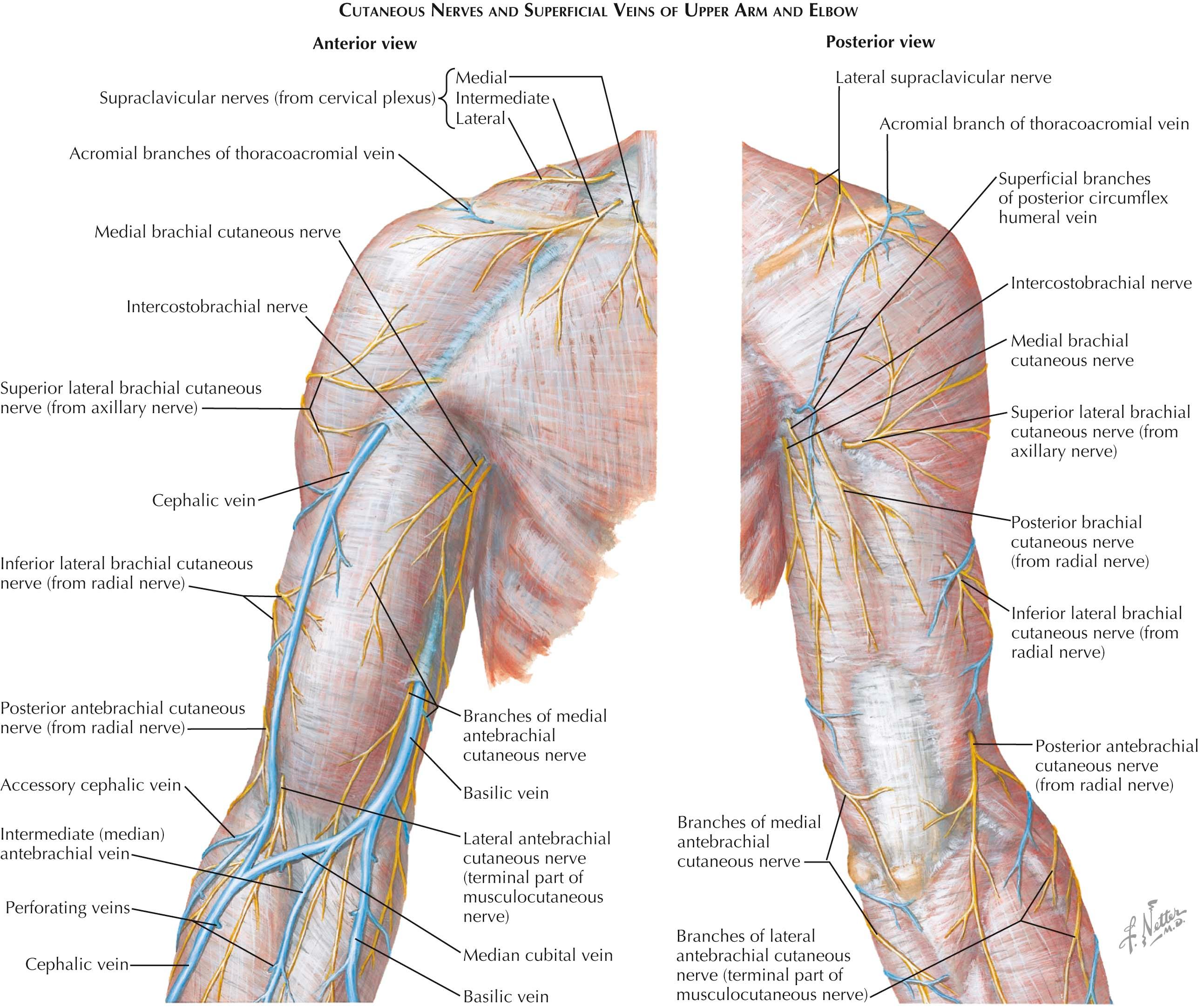
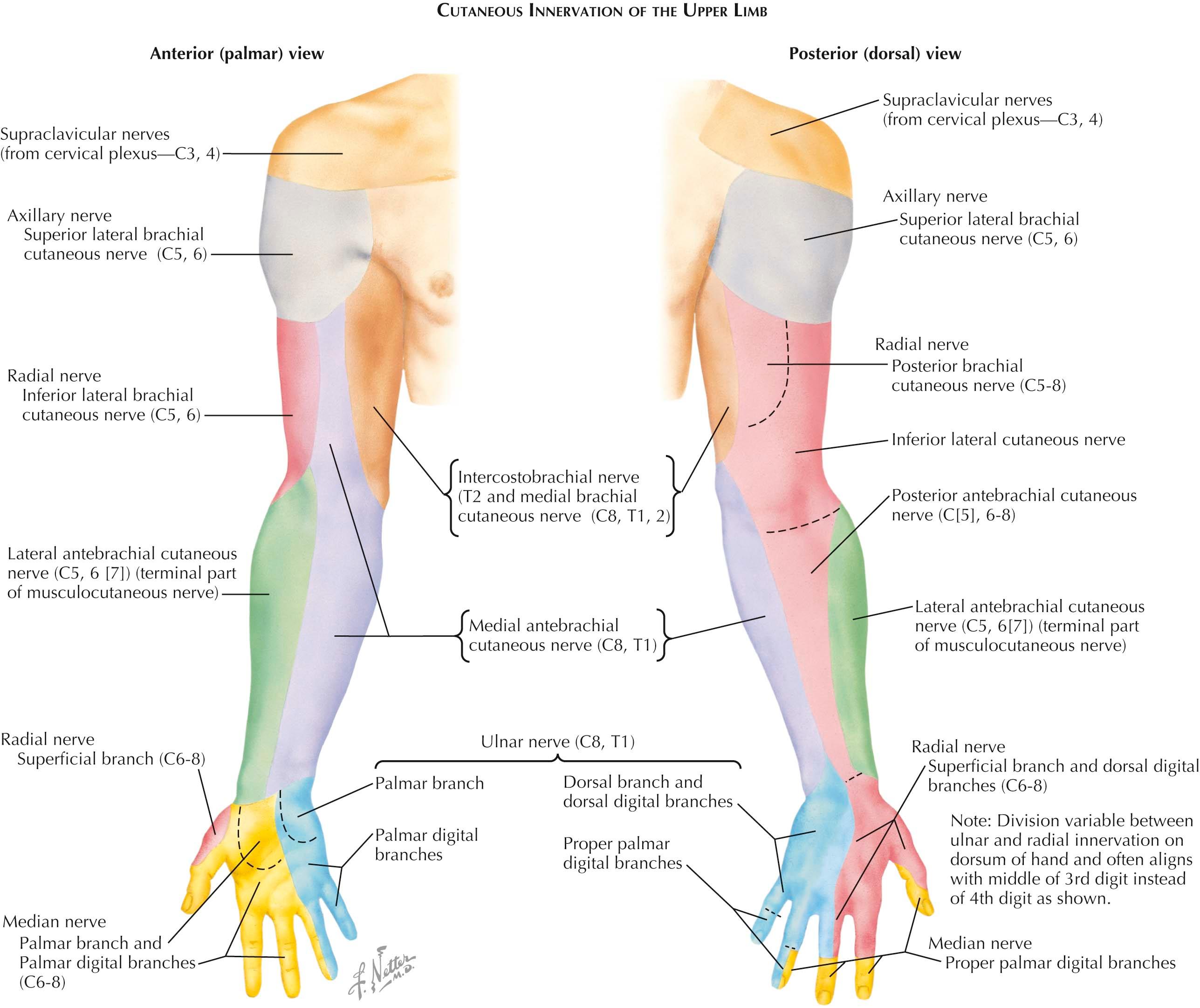
The cutaneous nerves of the upper limb and elbow are for the most part derived from the brachial plexus, although the uppermost nerves to the shoulder are derived from the cervical plexus. Some of the cutaneous nerves arise directly from the medial, lateral, or posterior cord of the brachial plexus, whereas others are terminal branches of the peripheral nerves of the upper extremity.
The supraclavicular nerves (C3, C4) become superficial at the posterior border of the sternocleidomastoid muscle within the posterior triangle of the neck. They pierce the superficial layer of the cervical fascia and the platysma muscle, radiating in three lines: (1) the medial supraclavicular nerves cross over the clavicle anteriorly to cover the shoulder more medially; (2) the intermediate supraclavicular nerves also run anteriorly and go toward the acromion laterally; and (3) the lateral or posterior supraclavicular nerves cross over the scapula to cover the shoulder posteriorly.
The superior lateral brachial cutaneous nerve (C5, C6) is the termination of the lower branch of the axillary nerve of the brachial plexus. Leaving the axillary nerve, it turns superficially around the posterior border of the lower third of the deltoid muscle to pierce the brachial fascia. Its cutaneous distribution is the lower half of the deltoid muscle and the long head of the triceps brachii in the most proximal aspect of the upper arm, both anteriorly and posteriorly.
The inferior lateral brachial cutaneous nerve (C5, C6) is derived from the posterior antebrachial cutaneous nerve shortly after this nerve branches from the radial nerve. The inferior lateral brachial cutaneous nerve becomes superficial in line with the lateral intermuscular septum a little below the insertion of the deltoid muscle. It accompanies the lower part of the cephalic vein and distributes in the lower lateral surface of the arm, below the area covered by the superior lateral brachial cutaneous nerve and extending both anteriorly and posteriorly.
The posterior brachial cutaneous nerve arises within the axilla as a branch of the radial nerve (C5 to C8). Traversing the medial side of the long head of the triceps brachii muscle, the nerve penetrates the brachial fascia to distribute in the middle third of the back of the arm, below the area covered by the superior lateral brachial cutaneous nerve, and lateral to the distribution of the medial brachial cutaneous nerve and the intercostobrachial nerve.
The medial brachial cutaneous nerve (C8, T1) arises from the medial cord of the brachial plexus in the lower axilla. It descends along the medial side of the brachial artery to the middle of the arm, where it pierces the brachial fascia and supplies the skin of the posteromedial surface of the lower third of the arm as far as the olecranon.
The intercostobrachial nerve is the larger part of the lateral cutaneous branch of the second thoracic nerve (T2). In the second intercostal space at the axillary line, it pierces the serratus anterior muscle to enter the axilla. Here, it usually anastomoses with the medial brachial cutaneous nerve and then pierces the brachial fascia just beyond the posterior axillary fold. Its cutaneous distribution is along the medial and posterior surfaces of the arm from the axilla to the elbow.
The medial antebrachial cutaneous nerve arises from the medial cord of the brachial plexus. A small branch pierces the axillary fascia and supplies the skin over the medial anterior area of the arm.
Cutaneous innervation about the elbow can be more variable and includes coverage by the inferior lateral brachial cutaneous nerve laterally and posteriorly, the medial brachial cutaneous nerve medially and posteriorly, and the medial antebrachial cutaneous nerve anteriorly. As the elbow continues into the proximal forearm, coverage is taken over by the antebrachial cutaneous nerves (medial, lateral, posterior). The medial antebrachial cutaneous nerve (C8, T1) is a continuation of the medial cord of the brachial plexus after the medial brachial cutaneous nerve, whereas the lateral antebrachial cutaneous nerve (C5, C6) is the terminal branch of the musculocutaneous nerve, running along next to the cephalic vein. The posterior antebrachial cutaneous nerve (C5 to C8) is another cutaneous branch of the radial nerve after the posterior brachial cutaneous nerve has branched off more proximally. All three of the antebrachial cutaneous nerves continue along distally to provide cutaneous innervation for the entire forearm, down to the level of the wrist.
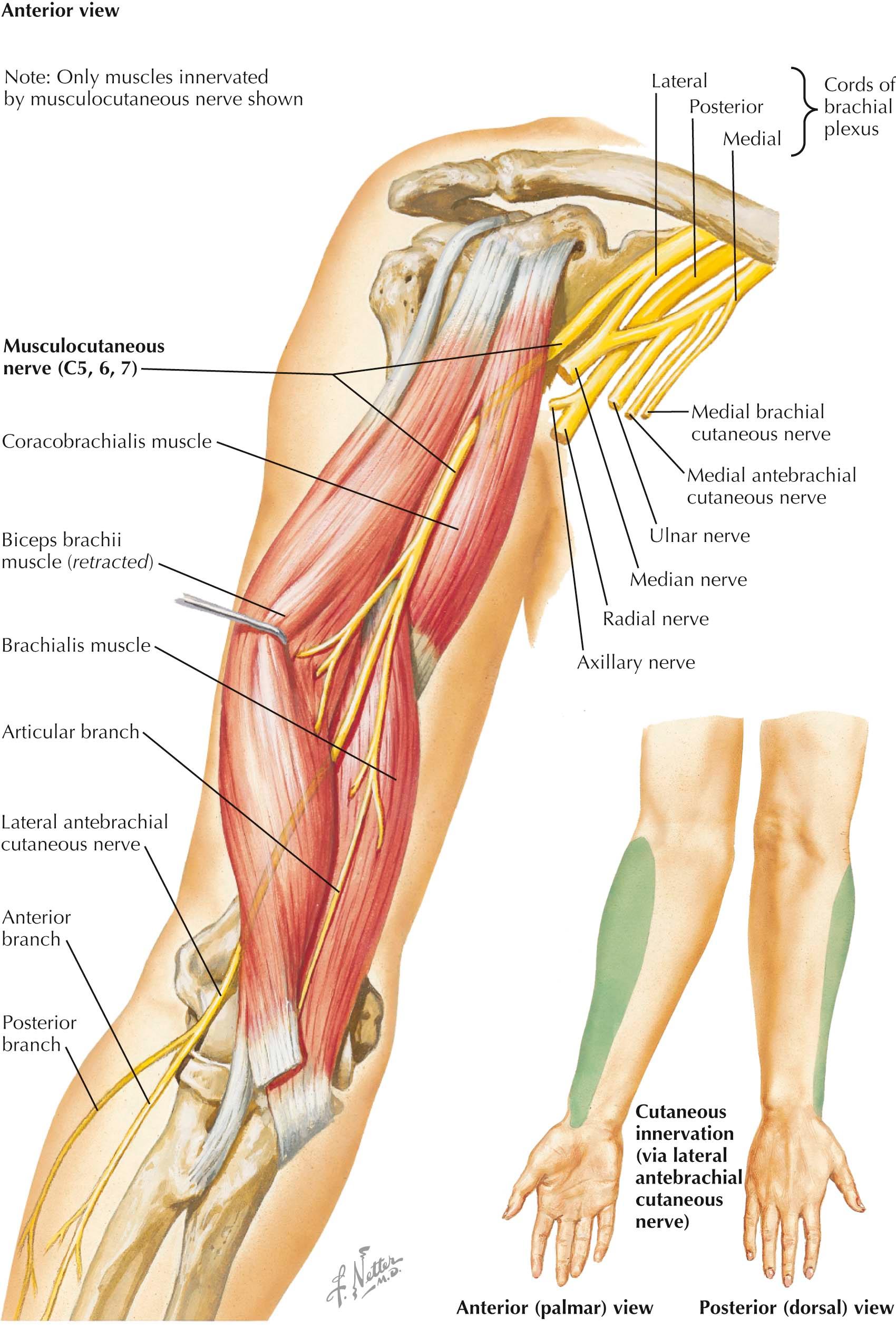
The terminal branches of the brachial plexus (the musculocutaneous, median, ulnar, and radial nerves) provide the entire nerve supply to the limb below the shoulder. Of these, only the musculocutaneous and radial nerves distribute to the muscles of the upper arm.
The musculocutaneous nerve (C4 to C7), a branch of the lateral cord of the brachial plexus, arises opposite the lower border of the pectoralis minor muscle. This nerve is the principal motor nerve of the anterior (flexor) compartment of the arm. It continues into the forearm as a cutaneous nerve, the lateral antebrachial cutaneous nerve. The nerve lies between the axillary artery and the coracobrachialis muscle, which it perforates and supplies. Continuing downward, it runs between the biceps brachii and brachialis muscles, supplying branches to both heads of the biceps brachii muscle and most of the brachialis muscle and often communicating with the median nerve. In this part of its course, it inclines gradually toward the lateral side of the arm; at about the level of the elbow joint, it passes between the biceps brachii and the brachioradialis muscles to pierce the deep fascia and become the lateral antebrachial cutaneous nerve.
The branch supplying the coracobrachialis muscle derives its fibers from C7 and usually arises from the main nerve before that nerve penetrates the muscle. Occasionally, the branch comes directly from the lateral cord of the brachial plexus. The branches to both heads of the biceps brachii muscle and to the brachialis muscle arise from the nerve after it has emerged from the coracobrachialis muscle.
The branch supplying the brachialis muscle subdivides and descends to help in the innervation of the elbow joint; other filaments supply the brachial artery and the deep brachial artery and its nutrient humeral branch. Fibers innervating the periosteum on the distal anterior aspect of the humerus are reputedly distributed with these vascular filaments.
The lateral antebrachial cutaneous nerve passes deep to the cephalic vein and soon divides into anterior and posterior branches. The anterior branch descends along the anterior aspect of the radial side of the forearm to the wrist and ends at the base of the thenar eminence. At the wrist, it lies in front of the radial artery and gives off branches that penetrate the deep fascia to supply this part of the artery. The terminal branches of the anterior branch of the lateral antebrachial cutaneous nerve communicate with corresponding branches from the palmar cutaneous branch of the median nerve. The posterior branch is smaller. It curves around the radial border of the forearm and breaks up into branches that supply a variable area of skin and fascia over the back of the forearm. These branches also communicate with branches of the posterior antebrachial cutaneous nerve and with the superficial terminal branch of the radial nerve.
The areas of skin supplied by the lateral antebrachial cutaneous nerve include sensory receptors, hairs, arrectores pilorum muscles, glands, and vessels. However, these terminal cutaneous branches show considerable individual variation in the territories they supply.
Become a Clinical Tree membership for Full access and enjoy Unlimited articles
If you are a member. Log in here